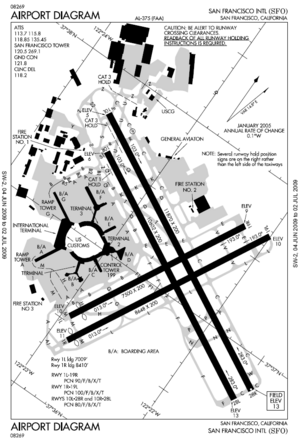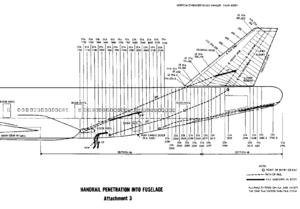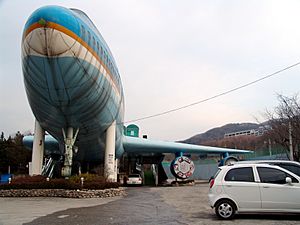Pan Am Flight 845 facts for kids
| Accident summary | |
|---|---|
| Date | July 30, 1971 |
| Summary | Struck structures past runway on takeoff (pilot error) |
| Place | San Francisco Int'l Airport San Mateo County, California United States |
| Passengers | 199 |
| Crew | 19 |
| Injuries (non-fatal) | 29 |
| Fatalities | 0 |
| Survivors | 218 |
| Aircraft type | Boeing 747-121 |
| Aircraft name | Clipper America Later: Clipper Sea Lark Clipper Juan T. Trippe |
| Airline/user | Pan Am |
| Registration | N747PA |
| Flew from | Los Angeles, California |
| Stopover | San Francisco Int'l Airport |
| Flying to | Haneda International Airport, Japan |
Pan Am Flight 845 was a large Boeing 747 airplane. It was flying from Los Angeles to Tokyo, Japan, with a stop in San Francisco. On July 30, 1971, as the plane was taking off from San Francisco International Airport, it hit some lights and structures at the end of the runway.
Even though the plane was damaged, the pilots kept flying it. They flew over the ocean to dump fuel, which made the plane lighter for landing. Then, they returned to San Francisco and landed safely. After the plane stopped, everyone had to leave quickly in an emergency evacuation. Two passengers were seriously hurt when the plane hit the structures, and 27 more were injured during the evacuation.
The accident was investigated by the National Transportation Safety Board (NTSB). They found that the pilots used the wrong speeds for takeoff. This mistake, along with other problems in how flight information was shared, led to the accident.
Contents
The Airplane and Crew
The airplane involved was a Boeing 747-121 named Clipper America. It was one of the first 747s ever made. At the time of the accident, it had flown for about 2,900 hours.
The flight crew had five members: a captain, a first officer, a flight engineer, and two relief crew members.
- The captain was Calvin Y. Dyer, who had a lot of flying experience, including on the 747.
- The first officer was Paul E. Oakes.
- The flight engineer was Winfree Horne.
- The relief pilot was Wayne E. Sagar.
- The relief flight engineer was Roderic E. Proctor.
All the crew members had been off duty the day before the flight. They had also flown the first part of the journey from Los Angeles to San Francisco.
What Happened During Takeoff
The crew of Flight 845 first planned to take off from runway 28L. However, they found out that this runway was closed for repairs. They then decided to use runway 01R. This runway was shorter than 28L and had less helpful wind conditions.
Runway 01R was about 8,500 feet (2,590 meters) long for takeoff. But due to some confusion, the crew thought it was 9,500 feet (2,896 meters) long. Even with the shorter runway, the plane could have taken off safely if the correct steps had been followed.
As the crew got ready, they set the plane's flaps to 20 degrees. This setting helps the plane lift off the ground. However, they forgot to recalculate the special takeoff speeds (called V speeds) for this new flap setting. Because of this, the speeds they used were too high for how the plane was set up.
This mistake meant the plane took too long to gain enough speed on the runway. The first officer noticed the end of the runway was coming up very fast. He called out the takeoff speed earlier than planned to try and lift off.
Damage to the Plane
Because the plane didn't get high enough, it hit parts of the approach lighting system (ALS) at the end of the runway. The plane was still going over 160 knots (296 km/h or 184 mph) when it hit.
- Three long pieces of metal from the ALS, up to 17 feet (5.2 meters) long, went through the plane's cabin. This injured two passengers.
- The right main landing gear was pushed up into the plane's body.
- The left landing gear was torn off and hung loose.
- Other parts of the plane were also damaged, including hydraulic systems, wing controls, and some emergency slides.
After hitting the structures, the flight continued over the Pacific Ocean for almost two hours. During this time, the crew dumped fuel to make the plane lighter for an emergency landing. Doctors who were passengers helped treat the injured people.
The plane then returned to the airport and landed on runway 28L. Six tires on the landing gear burst during landing. The plane slowly went off the runway and stopped. A small fire started on the left landing gear, but it went out when the plane went onto the dirt. After stopping, the plane tilted backward and rested on its tail. Before this accident, no one knew that a 747 could tilt like that without its main body landing gear.
Injuries to People
Thankfully, no one died among the 218 people on board. However, 2 passengers were seriously injured when the plane hit the structures. During the emergency evacuation after landing, 27 more people were hurt, with 8 of them having serious back injuries.
The metal rods from the approach lighting system went into the passenger area. One passenger had a severe leg injury, and another had a bad arm injury.
When the plane stopped, the crew ordered an evacuation. However, the message was accidentally sent over the radio instead of inside the cabin. A crew member had to leave the cockpit to tell people to evacuate. As people were leaving, the plane tilted backward onto its tail. The four emergency slides at the front of the plane became too high and windy to use safely. Most passengers used the six slides at the back. Eight passengers who used the front slides got serious back injuries and had to go to the hospital. Other passengers had minor injuries like scrapes and sprains.
The Investigation Findings
The National Transportation Safety Board (NTSB) investigated the accident. They released their final report in May 1972. The NTSB said the main reason for the accident was:
- The pilot used the wrong speeds for takeoff.
- This happened because of problems with how airport information was collected and shared.
- There were also issues with how the flight was planned and how the crew managed their duties.
- All these problems together meant the airline's safety system didn't work as it should have.
What Happened to the Plane Afterward
After the accident, the airplane was repaired and put back into service. It was even leased to another airline, Air Zaïre, for a while. Later, it returned to Pan Am and was renamed Clipper Sea Lark, and then Clipper Juan T. Trippe to honor the airline's founder.
The plane stayed with Pan Am until the airline closed down in 1991. It was then used by a few other airlines. In 1999, the plane was taken apart in California. Its pieces were shipped to Hopyeong, Namyangju, South Korea. There, the parts were put back together and used as a restaurant for some time. The restaurant eventually closed.
Many aviation fans wanted the historic airplane to be saved and put in a museum. However, the airplane was scrapped in 2010. There were some claims in 2017 that parts of the plane were saved and used as a church, but these claims were later proven to be false.
Images for kids
See also
 In Spanish: Vuelo 845 de Pan Am para niños
In Spanish: Vuelo 845 de Pan Am para niños








